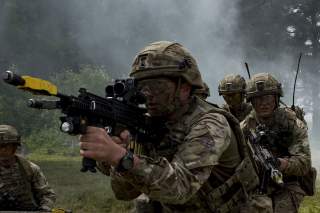The United Kingdom Has F-35s and New Aircraft Carriers (But the Army Is in Trouble)
The United Kingdom has new fighter jets, new drones, new aircraft carriers and new submarines. But its army? Well, the army is stuck with old tanks, old artillery and old fighting vehicles, many of them dating back to the 1980s.
The United Kingdom has new fighter jets, new drones, new aircraft carriers and new submarines.
But its army? Well, the army is stuck with old tanks, old artillery and old fighting vehicles, many of them dating back to the 1980s.
“It really is time for the army to become a modernisation priority,” Nicholas Drummond, a former British Army officer who is now a defense-industry consultant and commentator, tweeted on Oct. 22, 2019.
In his series of tweets the day before British defense secretary Ben Wallace set to meet with a key parliamentary committee, Drummond explained London’s relative lack of investment in the army at a time when the Royal Navy and Royal Air Force are benefitting from major modernization spending.
“For some, the army lost relevance when it was used to fight discretionary wars with ill-defined objectives, a lack of political commitment and an unaffordable resource requirement,” Drummond tweeted, referring to the American-led wars in Iraq and Afghanistan, to which the Brtish Army has committed tens of thousands of troops over a period of nearly 20 years.
“The truth is that Iraq and Afghanistan are in a much better state than if we had never deployed,” Drummond explained. But politically, in recent decades the Royal Navy and RAF have been in a better position to argue for expensive new hardware.
The army, after all, was fighting wars that for the most part didn’t require expensive new hardware. Sure, the British Army acquired new blast-proof trucks to protect against insurgents’ improvised explosives.
But the tanks, fighting vehicles and self-propelled artillery that enable the army to fight a major war mostly haven’t played a major role in counterinsurgencies. The army didn’t need them for the wars it was in, so the government didn’t bother upgrading or replacing them.
So the lion’s share of modernization spending went to the navy and air force. Over the last decade, the Royal Navy has brought into service the Type 45 destroyer, the Queen Elizabeth-class carrier, the Astute-class attack submarine. Dreadnought-class missile submarines and Type 26 and Type 31 frigates are in production.
“By any objective standard, the U.K. has a world-class navy,” Drummond tweeted.
“Similarly, the Royal Air Force has brought into service the F-35B, FGR4 Typhoon, A400M [airlifter] and will soon have MQ-9B Predator UAV, P-8A Poseidon [patrol planes] and E-7 Wedgetail [radar planes],” Drummond added. “F-35B and A400M have not been without problems, but overall, we also have a world-class air force.”
At the same time, the army got … well, next to nothing, Drummond pointed out. “The British Army has been unable to replace FV432 or CVR(T) [armored vehicles]. It's failed to upgrade Challenger [tanks], Warrior [fighting vehicles] and AS90 [artillery].”
“If our army is world-class, it is because of our people not its equipment.”
“The army is the poor relation of U.K. defense,” Drummond tweeted. “It lacks personnel, protected mobility and firepower. Its infrastructure is in a shocking state. It needs a larger training budget. And soldiers are still leaving faster than they can be replaced.”
With China’s rise and Russia’s resurgence, the British Army “needs to be able to fight peer adversaries,” Drummond warned. “If we continue to allow the army to atrophy, we risk nor being able to rebuild it quickly enough in a time of real crisis.”
“The army has a clear sense of its own strategic priorities,” Drummond concluded. “It is acutely aware of resource shortages and has shown a willingness to operate within a tightly constrained environment. Unfortunately, there is no substitute for the hardware it needs to be effective in ground combat.”
Parliament did offer a glimmer of hope that change could come for the United Kingdom’s beleaguered ground forces. During defense minister Wallace’s meeting with the parliamentary committee on Oct. 23, 2019, the committee chair said the United Kingdom should spend three percent of its GDP on the military, up from around two percent today.
“Fantastic,” Drummon tweeted in response.
David Axe serves as Defense Editor of the National Interest. He is the author of the graphic novels War Fix, War Is Boring and Machete Squad.

